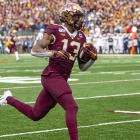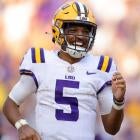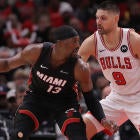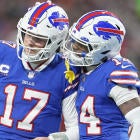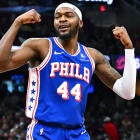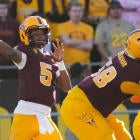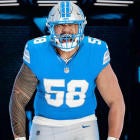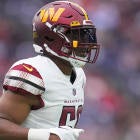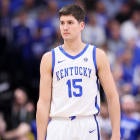
Draft grade season is upon us, and we decided to take a slightly different, more micro angle with this article. Instead of providing a grade for the entire draft class, let's highlight the finest pick made by every franchise in the 2021 NFL Draft.
Here are the best individual picks for all 32 teams. Value was slightly factored in, as was opportunity for said draft pick to produce in the NFL. I also included an honorable mention.
Arizona Cardinals
Rondale Moore, WR (Round 2, No. 49 overall)
Honorable mention: Tay Gowan, CB
When in doubt, go offense -- my newest draft philosophy, one I incorporated here. I wavered between Moore and sixth-round selection Gowan, who I believe has a real opportunity to play a significant amount of snaps in Arizona's revamped defensive backfield.
But Moore's my pick because he plays offense and offense moves the needle more today than defense. I had a first-round grade on Moore. On film, he was an easy top 25 talent in this class. Moore and Jaylen Waddle were the two prospects I thought were going to score a touchdown every time they touched the ball. And as for the "size" concerns, Moore is 2 1/2 inches shorter than Waddle but weighed one pound more than him at his pro day. He's "short" not "small." And that lower-half power yields freaky contact balance.
Kliff Kingsbury features a litany of creatively designed quick screens to receivers, so there shouldn't be any problems deciding how to utilize Moore. He's the road runner.
Atlanta Falcons
Richie Grant, S (Round 2, No. 40 overall)
Honorable mention: Drew Dalman, IOL
Take Grady Jarrett out of the equation -- anyone else feel like the Falcons have been devoid of a star on defense for seasons now? Exactly. That defensive dip has coincided with Atlanta's downward spiral after losing Super Bowl LI.
And with Grant, they picked a defender with star potential. He was a first-round prospect on my board. He's capable of everything you need from a modern-day safety. He has high-level athletic traits, and was very productive during his career at UCF. He nearly averaged 100 tackles per season in his last three collegiate campaigns with 10 total interceptions, 17 pass breakups, and five forced fumbles. That kind of stat line doesn't materialize out of nowhere.
Grant can comfortably cover the slot, range from the deep middle as a free safety, strike against the run as a strong safety and rob the intermediate level in a freelancing role.
Baltimore Ravens
Rashod Bateman, WR (Round 1, No. 27 overall)
Honorable mention: Tylan Wallace, WR
We're all aware the Ravens are a run-based team. Even in a regression year for Lamar Jackson from his phenomenal MVP-winning season in 2019, the electric quarterback carried the football 159 times and again led the league in yards per carry (6.3). As a team, the Ravens led the league in rushing yards per game for the second consecutive season (191.9) and called a handoff more than any other team during the regular season (555 times).
But they've become a glaring example of why passing is more efficient than rushing in today's NFL. Baltimore, a team that boasts the most dominant ground game the league has to offer, averaged 5.6 yards per run play in 2020 but 7.1 yards per play on passes. To increase its chances of staying with/surpassing the Bills and Chiefs in the AFC, the Ravens need to get more efficient offensively. And that's done by boosting the pass game.
Bateman can be instrumental in lifting Baltimore's aerial attack with Jackson at the center of it. The Minnesota product proved he can routinely win from the slot or the perimeter, run crisp, separation-generating routes, come down with the football in traffic, and create big plays in classic YAC situations. He had over 1,200 yards and 13 scores at 20.3 yards per grab in 2019 before settling into a possession role last season (36 catches for 472 yards and two scores).
Buffalo Bills
Carlos Basham, EDGE (Round 2, No. 61 overall)
Honorable mention: Marquez Stevenson, WR
The Bills have the quarterback. They have the offensive weapons. They brought back their entire offensive line. Their meaningful weakness in 2020 was converting pressures to sacks as a defense. Despite finishing second in ESPN's "Pass-Rush Win Rate" in 2020 (52%), their 38 regular-season sacks were tied for 15th in the league.
In Round 1, they picked Gregory Rousseau, who managed 15.5 sacks as a redshirt freshman at Miami in 2019. He's very raw but undeniably has the traits to finish the play with a quarterback takedown. Basham was Buffalo's selection in Round 2, and he's another edge rusher with serious sack production on his draft resume. In his last 1,008 pass-rushing snaps at Wake Forest, the thick, explosive, and bendy rusher registered 24 sacks. That's a 2.3% conversion rate. Seems low. It's not. Colts' first-round pick Kwity Paye's sack conversion rate was 1.3% during his three seasons at Michigan.
Basham's an amazing mover for his size -- close to 280 pounds at around 6-4 -- and learned outstanding pass-rushing moves in college packed with springy power. Basham will be significantly more of an instant impact rusher than Rousseau on the Bills heavy defensive line rotation in a vital season in Buffalo.
Carolina Panthers
Daviyon Nixon, DT (Round 5, No. 158 overall)
Honorable mention: James Hudson, OL
I'm confused as to why Nixon was available in the fifth round. First the eye test -- he's over 6-3 and 313 pounds with stupidly long 35 1/8-inch long arms. Per Mockdraftable, he tested like an above-average athlete at the defensive tackle position. In terms of production, Nixon emphatically checked that box too with seven sacks and 23 total pressures on 256 pass-rush snaps in 2020.
In terms of on-field traits, Nixon is an agile, side-to-side rusher who threatens multiple gaps because of that lateral movement specialty and understands how vital his hands are when attacking the quarterback. He should've been picked much earlier than No. 158 overall. And what a situation for him -- playing on the same defensive line as block-devourer Derrick Brown in Carolina.
Chicago Bears
Justin Fields, QB (Round 1, No. 11 overall)
Honorable mention: Dazz Newsome, WR
Didn't try to get too cute with my Bears selection. I thought Chicago had the finest draft of any team in the NFL and the ascension for Fields is at the heart of it.
Fields was an elite prospect, don't let anyone tell you differently. From outstanding arm strength to precise ball placement to freaky athletic traits for the quarterback spot, he is ready to lead an NFL organization from Day 1. And the Bears have been scouring God's green earth for a franchise quarterback for decades.
As a draft analyst, I'm naturally averse to trading up. Don't lessen your opportunities to make a selection. The one exception is for a quarterback, because no position can alter the course of a team more than a quarterback. And what Chicago surrendered to move from No. 20 to No. 11 overall aligned with our very own mad scientist R.J. White's draft trade value chart.
Chicago didn't overpay for a dynamic quarterback prospect in yet another year in which it desperately needed one. Win. Fin.
Cincinnati Bengals
Joseph Ossai, EDGE (Round 3, No. 69 overall)
Honorable mention: D'Ante Smith, OL
I had a late first-round grade on Ossai, which made this selection a piece of cake. He just feels like someone who's going to erupt in the NFL. Some reasons -- he just turned 21 years old a few weeks ago and had 5.5 sacks and 15.5 tackles for loss last fall at Texas. That's freaky stuff. Not to mention, Ossai registered five sacks and 13.5 tackles for loss in 2019. Unreal.
He has an NFL body at close to 6-4 and 256 pounds with long arms and tested through the roof at the Texas pro day. Matthew McConaughey was quoted after watching Ossai's performance, saying "alright, alright, alright." On film, Ossai threatens with major explosion and decent bend to the quarterback, and he's just scratching the surface with his pass-rushing moves -- they clearly improved in one-on-one situations from where they were in 2019.
Craving even more NFL coverage focusing on previews, recaps, news and analysis? Listen below and follow the Pick Six podcast for a daily dose of everything you need to follow pro football.
Cleveland Browns
Jeremiah Owusu-Koramoah, LB (Round 2, No. 52 overall)
Honorable mention: Greg Newsome II, CB
Since the draft, we've learned Owusu-Koramoah had a heart issue flagged by some teams, which likely precipitated his drop to No. 52 overall. The Browns medically cleared him, and got a future All-Pro in the second round.
Owusu-Koramoah was my highest-graded defender in this class, a second-level rocket who covers like a safety and brings an awe-inspiring controlled chaos style to the field. The man had 24.5 tackles for loss in his 25 games for the Fighting Irish, in case you needed to be made aware of his propensity to create splash plays. He also defended seven passes and forced five fumbles.
He can flex out into the slot and run with pass catchers because of his electric athletic gifts. He can run with tight ends down the seam or running backs on wheel routes. And Owusu-Koramoah repeatedly showcased the ability to find the ball in the air and make a play on it. He glides through traffic on outside runs and lays the wood regularly.
Cleveland has long needed a true playmaker at the linebacker position, and it got that in spades with Owusu-Koramoah in Round 2.
Dallas Cowboys
Jabril Cox, LB (Round 4, No. 115 overall)
Honorable mention: Osa Odighizuwa, EDGE/DL
Dallas picked linebacker Micah Parsons at No. 12 overall, but I actually liked the selection of Cox in Round 4 more. Sure, Parsons is immediately a starter -- I think? -- but Cox comes into the NFL more ready to cover than Parsons. Leighton Vander Esch is the best three-down, second-level defender on the Cowboys roster, but he's been plagued by injury in his NFL career.
Jaylon Smith is a missile sideline to sideline, yet gets stuck to blocks too often and isn't a reliable coverage type.
All Cox did in 2020 was transfer from North Dakota State to LSU -- no big deal, right? -- intercept three passes, house one of them, knock down five others, and have 6.5 tackles for loss along with 64 total takedowns in 10 games. The 6-3, 232-pounder with long arms is silky smooth in man coverage and demonstrated exquisite instincts in zone -- those attributes simply aren't part of Parsons' game right now.
Cox will have an uphill battle finding playing time. But don't be stunned when he's the more reliable linebacker in Dallas in a few seasons, because coverage is king at the linebacker spot in today's NFL.
Denver Broncos
Jamar Johnson, S (Round 5, No. 164 overall)
Honorable mention: Kary Vincent Jr., CB
Johnson is a rare safety prospect because of his deadly combination of range and ball-tracking talent. The 6-0, 205-pound safety had six interceptions in his final two seasons at Indiana and repeatedly made his instincts, closing speed, and awareness very noticeable.
And that assertive nature translates against the run, too, although he does tend to dip his head and not see what he's hitting, a tackling style that is dangerous and unreliable.
Back to the coverage skill -- the Broncos have one of the best two-way safeties in football in Justin Simmons. Kareem Jackson's a steady veteran, too, but just turned 33. Johnson can be eased onto the field as a rookie and has the traits and route-recognition skills to turn in some game-altering plays for the Broncos.
Detroit Lions
Ifeatu Melifonwu, CB (Round 3, No. 101 overall)
Honorable mention: Levi Onwuzurike, DT
Melifonwu would've been picked early had he entered the NFL about 10 years ago, when many gargantuan receivers roamed the NFL. But while it's easy to assume a 6-2 1/2-inch, 205-pound cornerback won't be able to withstand NFL receiver agility, Melifonwu looked like an exception on film.
There's no doubting his explosiveness -- 4.50 in the 40-yard dash, 41 1/2-inch vertical and 134-inch broad jump -- but I noticed quality mirroring skills down the field. He had three picks and 19 pass breakups across three years at Syracuse. And ask fellow third-round pick Dyami Brown how sticky Melifonwu is. The tall corner dominated his matchup with the North Carolina star. I love, too, how physical and driven Melifonwu is ripping through blocks and making tackles on the perimeter. His size and length absolutely help him on those plays, but the aggressive consistency isn't always a given with cornerbacks in that regard.
Detroit is rebuilding, and because of his size and athleticism, Melifonwu represents phenomenal upside at a critical position in today's NFL -- outside corner.
Green Bay Packers
Amari Rodgers, WR (Round 3, No. 85 overall)
Honorable mention: Royce Newman, OL
Rodgers for Rodgers! What a sweet gesture from GM Brian Gutekunst. Moving away from the Aaron Rodgers fiasco, Green Bay landed a high-floor wideout in Rodgers from Clemson in Round 3. Do I ever think he'll be a 1,300-yard, 12-touchdown receiver? No. But he won't be invisible with the Packers. Why? Because he's a monster after the catch, meaning, Rodgers -- or whoever's throwing passing inside Lambeau Field over the next few years -- can lean on Amari to take quick, high-percentage throws and make the most of them.
He forced 17 missed tackles in 2020, the seventh-most among all receivers in this draft class. Rodgers carries the ball like a running back after the catch because he's built like a running at just under 5-10 and 212 pounds. We saw at the Senior Bowl that he possesses just enough athleticism to stop and start quickly to get open underneath, and that's where he's going to making his living with the Packers. Rodgers quietly went over 1,000 yards receiving in his final season at Clemson.
Houston Texans
Davis Mills, QB (Round 3, No. 67 overall)
Honorable mention: Nico Collins, WR
If you aren't sure what the future holds for your quarterback, it's probably a good idea to pick one as fast as humanly possible, and that's precisely what new Texans GM Nick Caserio did.
Mills was Houston's first pick in the 2021 NFL Draft, and given the serious off-field issues regarding Deshaun Watson, there's a growing likelihood that it's going to be a while before he's playing football again. The Texans did sign Tyrod Taylor in free agency, and he's a quality bridge quarterback. But Mills provides serious upside, not just because he's young.
On film at Stanford, the former No. 1 pro-style quarterback recruit in the country demonstrated why he was so highly regarded out of high school on a handful of occasions. He has a strong arm that really drives the football, and while Mills won't ever be confused for Cam Newton athletically, he's not stiff inside the pocket. Strictly based on positional value alone, this was the correct decision. And remember, Mills didn't even start 15 games in college, so he's a moldable ball of clay.
Indianapolis Colts
Will Fries, OL (Round 7, No. 248 overall)
Honorable mention: Kwity Paye, EDGE
Heading to the seventh round for the best Colts pick, mostly because I was confused as to what Indianapolis was doing during this draft (and Chris Ballard is one of the better GMs in the NFL). Sam Tevi is not the answer at left tackle, and Carson Wentz has proven to be horrific when pressured regularly.
So I'm going with the one offensive lineman Indianapolis selected in this draft. And he has a case for being the most truly versatile blocker in the class. Fries played four different positions up front during his illustrious 48-game career at Penn State. At nearly 6-7 and 309 pounds, he has room to add more weight to his frame, and the power element is where he needs to improve. But that's relatively easy for offensive linemen to do in the NFL.
Do I think Fries will immediately become the lockdown left tackle the Colts desperately need? No. But he'll be a valuable commodity on that sturdy offensive line because of his versatility and experience.
Jacksonville Jaguars
Andre Cisco, S (Round 3, No. 65 overall)
Honorable mention: Trevor Lawrence, QB
Cisco was my third safety with a first-round grade, he was thrilling to watch on film. And the stat book doesn't lie with him whatsoever -- seven interceptions as a freshman, five in 2019 and one in his two games in 2020 -- Cisco is the most rangy safety to enter the NFL since Malik Hooker and Marcus Williams in 2017.
Plus, at 6-1 and 216 pounds, Cisco is built like he's already been in an NFL weight room for a few seasons. And that size and chiseled frame yields thumping ability as a run defender, too. Before his torn ACL early in the 2020 season -- which happened in pregame warmups -- Cisco had taken 49 snaps in the box compared to 70 at free safety, and the twitch and acceleration to the football popped on film.
The Jaguars need an eraser on the back end of their defense, and when healthy, that is precisely what Cisco is.
Kansas City Chiefs
Cornell Powell, WR (Round 5, No. 181 overall)
Honorable mention: Trey Smith, IOL
The Chiefs want to beat you with suddenness and speed in their receiver room, but it never hurts to diversify. It's like spreading out your money between Bitcoin, Ethereum, and Doge.
And Kansas City diversified its passing game with the selection of Powell in Round 5. He's a large, rocked up, back-shoulder, rebounding specialist -- with surprisingly good route-running chops for a 6-0, 204-pounder. Now, he did have his breakout season in college as a 23-year-old, and history tells us old, one-year wonders typically don't amount to much in the NFL.
But there are caveats to consider here with Powell and his landing spot. Firstly, in his Clemson career, he played alongside Mike Williams, Justyn Ross, Hunter Renfrow, Tee Higgins and Amari Rodgers -- not a cinch to stick out in that group. And he'll be catching passes from Patrick freaking Mahomes in Andy Reid's brilliant constructed offense.
Los Angeles Chargers
Asante Samuel Jr., CB (Round 2, No. 47 overall)
Honorable mention: Josh Palmer, WR
Samuel was my No. 2 cornerback in this class. [whispers] I think Patrick Surtain and Jaycee Horn were overrated inside the top 10.
The Florida State star has the physical attributes to thrive in today's NFL because he's incredibly sudden and finds the football as instinctively as his dad did. Samuel likely fell to the second round because he's only 5-10 and weighs 180 pounds with arms hardly over 30 inches.
But I never saw his size hurt him while playing primarily on the outside in the ACC. And the size difference at receiver between college and the NFL is negligible. Samuel ran 4.41 and had 35-inch vertical at the Florida State pro day. He's a good athlete. And he had 29 pass breakups and four interceptions in his three years with the Seminoles -- big-time production.
The Chargers were rumored to be in the cornerback market in Round 1, with that position clearly needing to be upgraded early in the draft. Instead they get, to me, the cleanest cornerback prospect in this class in Round 2.
Los Angeles Rams
Bobby Brown III, DL (Round 4, No. 117 overall)
Honorable mention: Ernest Jones, LB
Brown is a mammoth individual at 6-4 and 321 pounds with nearly 35-inch tentacles attached to his body. He's a nose tackle then, right? Wrong. Well, maybe by positional designation, he will be, but the Texas A&M star is an upfield pass rusher. He had six sacks and 17 total pressures on 186 pass-rushing snaps in 2020 and is set to play next to the one and only Aaron Donald in Los Angeles.
On film, Brown's traits are tremendous for a man of his size -- seriously threatening first-step quickness, fast, well-developed pass-rushing moves. He just needs to show more down-to-down consistency. But it's not shocking Brown's not the steadiest player in this class. He's still not 21 years old.
Las Vegas Raiders
Trevon Moehrig, S (Round 2, No. 43 overall)
Honorable mention: Malcolm Koonce, EDGE
Moehrig had no business going in the second round. None at all. He was the consensus top safety in #DraftTwitter and pieced together back-to-back spectacular campaigns as a pesky, do-it-all safety at TCU. In 2019, Moehrig had four picks and 11 pass breakups in 12 games. This past year, two interceptions and nine defended passes in 10 outings.
At nearly 6-1 and 208 pounds, Moehrig has quality size for the safety position, and he made slipping into the slot for coverage duties seem like a walk in the park. That's huge into today's NFL. He's rangy deep down the field, too, and is a quick-reacting, acceleration-based tackler.
The Raiders haven't gotten what they hoped for out of 2019 first-round pick Johnathan Abram, and that's mostly due to his coverage deficiencies -- which were very apparent at Mississippi State, mind you. Moehrig has the well-rounded, NFL-ready skill set to hit the ground running in Vegas.
Miami Dolphins
Jaylen Waddle, WR (Round 1, No. 6 overall)
Honorable mention: Jaelan Phillips, EDGE
The Dolphins made the right decision going Waddle over DeVonta Smith, even though both were elite-level receiver prospects. Waddle was my No. 1 wideout in this class. He has the most explosive, dynamic skill set of any wideout in the class and has a case as the fastest. Plus, he plays like he's 6-4 because of his leaping ability and ball-tracking mastery.
And Tua Tagovailoa needs help. Not that DeVante Parker, Jakeem Grant, Mike Gesicki and Co. represent an uninspiring collection of pass-catching options. But a familiar receiver for Miami's quarterback was needed. The Dolphins need to see what they have with Tagovailoa this season, and Waddle is the closest receiver we've seen to Tyreek Hill. He averaged 19 yards per grab on his 106 catches at Alabama, and I love that he was an incredible returner, too. That translates after the catch.
Minnesota Vikings
Jaylen Twyman, DT (Round 6, No. 199 overall)
Honorable mention: Wyatt Davis, IOL
I never saw Twyman as an high-caliber defensive tackle prospect despite his production, but sixth round, No. 199 overall? Vikings got a outstanding value here.
Don't let the No. 97 and a productive interior rusher from Pittsburgh fool you into thinking Twyman is Donald 2.0. He's not. But there are similarities in their games. Twyman has a well-developed arsenal of pass-rushing moves and can win at the outset of the snap with a quick first step. That combination was instrumental in his 10.5-sack, 12.5 tackle for loss 2019.
He's not the most athletic once he gets moving and does tend to play high, so there's not much power to his game. But Mike Zimmer loves himself some inside rushers, and Minnesota's starting defensive tackles are run-stuffers Dalvin Tomlinson and Michael Pierce.
New England Patriots
Ronnie Perkins, EDGE (Round 3, No. 96 overall)
Honorable mention: Christian Barmore, DT
Perkins is a classic stand-up rush linebacker Bill Belichick has had an affinity for his entire coaching career. Because of his burst and strength, he sets a sturdy edge and is actually faster than he is quick around the corner. The pass-rush move collection is workable.
Matthew Judon and Chase Winovich are the top pass rushers on the Patriots roster. Judon is an established player. Winovich has flashed. But there was certainly a need to add to the group, especially playing in a division with Josh Allen.
And Perkins was wildly productive in 2020 at Oklahoma -- 32 pressures on just 179 pass-rushing snaps. He's pretty bendy, too. Expect Belichick to allow Perkins to pin his ears back and get after the quarterback as a rookie as the third man in the rotation.
New Orleans Saints
Pete Werner, LB (Round 2, No. 60 overall)
Honorable mention: Paulson Adebo, CB
Werner was my favorite Ohio State linebacker in this class -- two were picked and Justin Hilliard was the on the radar. At close to 6-3 and 238 pounds, Werner tested like an elite athlete at the position and plays like it.
He flips his hips like a safety and showcased awesome instincts drifting out of zones when needed to disrupt. He had 13 pass breakups and four forced fumbles to go along with 16 tackles for loss in his three seasons as a regular contributor for the Buckeyes.
The Saints have All-Pro Demario Davis at linebacker. Wouldn't hurt to get another playmaker next to him. Werner is that guy.
New York Giants
Azeez Ojulari, EDGE (Round 2, No. 50 overall)
Honorable mention: Aaron Robinson, CB
Ojulari was my EDGE1 in this class. Explosive, bendy, and shockingly strong with his hand work. And for being a smaller rusher around the corner, he plays the run with serious power to stack and shed outside blockers.
The Giants stopped his slide in the middle of the second round. New York's defense flashed down the stretch in 2020 and added Adoree Jackson in free agency at corner. There was a clear need on the edge, and Ojulari can be an alpha rusher in the NFL. He had 37 quarterback pressures on 193 pass-rushing snaps at Georgia in 2020, and he doesn't turn 21 until mid-June.
Sky's the limit for him.
New York Jets
Elijah Moore, WR (Round 2, No. 34 overall)
Honorable mention: Zach Wilson, QB
Surrounding your young quarterback with quality receivers is an absolute must. After picking Wilson, GM Joe Douglas traded up for Alijah Vera-Tucker (while a little pricey) then landed this sure-fire slot wideout at the top of Round 2.
Moore was a Round 1 receiver on my board. There's just no way he won't at least be a serviceable player in the NFL. And there's a good chance he borders on stardom with the Jets. Moore is a twitched-up, hard-nosed slot who gets open at all levels of the field and catches everything.
His production improved across the board in all three years at Ole Miss, and he just turned 21 at the end of March. Moore is going to be a high-volume possession -- and occasionally deep-ball -- target for Wilson with Gang Green. Needle-mover.
Philadelphia Eagles
Milton Williams, DT (Round 3, No. 73 overall)
Honorable mention: DeVonta Smith, WR
This pick is more based on value than anything else. And because the Eagles seemingly have a type at the defensive tackle spot after signing Javon Hargrave in free agency. Actually, Hargrave is a good comparison for Williams as a prospect. Easy unlocking of his hips when attacking up the field. Good arsenal of pass-rushing moves and a high motor.
I'm just concerned about Williams' level of competition leading to a longer acclimation process once he's in an Eagles uniform. But his athleticism cannot be overrated. Williams was the most gifted defensive tackle in the class as a pure pass rusher, and there's major value in that ability. His athletic prowess indicates he has the physical attributes to thrive inside, and learning from Cox will bode well for his future in Philly.
Pittsburgh Steelers
Kendrick Green, IOL (Round 3, No. 87 overall)
Honorable mention: Dan Moore Jr., OT
After their first two picks, everyone -- including myself -- wondered what the Steelers were doing. Where were the offensive linemen? The Najee Harris pick in Round 1 would be rendered useless if Pittsburgh didn't address its recently ravaged blocking unit. And Ben Roethlisberger, nearing 40, needs to be well-protected.
Then Pittsburgh's shrewd GM Kevin Colbert showed why he's long been one of the best at his job in the NFL. In Round 3, Green was picked. To me, he was the best pure center in the entire class. At just under 6-2 and 305 pounds, Green plays with a tremendous blend of explosion and power. He has guard versatility, too.
Green is one of the rare interior blockers who has the physicality and footwork to start and thrive as a rookie. He even has room to add a little bit of weight to his frame to improve his anchor, which was already a strength on film.
San Francisco 49ers
Trey Lance, QB (Round 1, No. 3 overall)
Honorable mention: Trey Sermon, RB
Layup here. Overall, I was confused by the 49ers draft. But the organization made the correct decision for their most important one -- picking Lance over Mac Jones at No. 3 overall. That was one of the selections during Round 1 that got me off my seat on the couch.
Jones would've been a good quarterback in San Francisco -- Lance has All-Pro potential with Kyle Shanahan. He may not be able to start Week 1, but a half-season redshirt might be in the works, and that might be enough time for the ultra-talented passer from North Dakota State to acclimate to the speed of the NFL.
My comparison for Lance pre-draft was Josh Allen, and we know what Allen did in 2020 to the 49ers on "Monday Night Football" and to the rest of the NFL. With Lance, there are new possibilities with Shanahan's time-tested system by way of the designed run game with the athletic passer. The last time Shanahan had a passer who could threaten a defense with his legs was 2012 when Robert Griffin III won Offensive Rookie of the Year.
Seattle Seahawks
Tre Brown, CB (Round 4, No. 137 overall)
Honorable mention: Stone Forsythe, OT
The Seahawks love long perimeter corners, right. Well, yeah they still do, but it's cool that they bucked the trend with the super-feisty nickel corner from Oklahoma in Round 4. Yes, Brown mostly patrolled the perimeter for the Sooners, but at just under 5-10 and 185 pounds with arms not even 31 inches long, his home is likely to be inside in the NFL.
He was one of my favorite watches on film among all cornerbacks in this class -- an in-your-face battler with the explosion in his lower half to follow receivers at all levels and routinely make plays on the football. He had 29 pass breakups and four interceptions in his final three years in Norman. Dude can play.
Tampa Bay Buccaneers
Robert Hainsey, OL (Round 3, No. 95 overall)
Honorable mention: Joe Tryon, EDGE
The Buccaneers are pretty set. If you haven't noticed. The one itty bitty tiny weakness Tampa Bay had in 2020 was the interior of its offensive line after Ali Marpet went down with injury. The depth on the inside was ugly.
And Hainsey, while a right tackle at Notre Dame, has a future on the inside because of his frame. He's 6-4, 306 pounds and has arms just over 32 inches. That's guard size. Of all the blockers I evaluated in the 2020 class, Hainsey had the most impressive grip strength despite not being a masher. He epitomizes the scouting phrase "once he locks on, it's over," and the Fighting Irish star has four seasons of experience on his draft resume. He plays with noticeable burst off the ball, too.
Down the road, or even if there's another injury at guard or center in 2021, Hainsey will be a critical piece to Tampa's offense.
Tennessee Titans
Dez Fitzpatrick, WR (Round 4, No. 109 overall)
Honorable mention: Dillon Radunz, OT
Fitzpatrick was unique in this draft class loaded with smaller, twitched-up speedsters -- he has downfield juice and legitimate separation-generating, route-running capabilities -- at almost 6-2 and 208 pounds with long arms and big hands.
Fitzpatrick contributed for all four seasons at Louisville. He actually had the most catches in his career as a freshman in 2017. But Fitzpatrick's production was capped with the Cardinals because of shoddy quarterback play. On 154 catches, Fitzpatrick averaged a bulky 16.8 yards per reception. In 2020, he had grabs of 69, 70, and 82 yards. He's explosive.
And the Titans just lost Corey Davis in free agency. Fitzpatrick will fill his role out on the outside instantly.
Washington Football Team
Jamin Davis, LB (Round 1, No. 19 overall)
Honorable mention: Benjamin St-Juste, CB
Davis reminds me a lot of Leighton Vander Esch or Tremaine Edmunds -- he's tall, twitchy, and can make plays in coverage. He's good sifting through traffic en route to the ball-carrier.
Like Edmunds, Davis takes an extra split second reacting to his keys. That means he doesn't fully play to his athleticism. Yet. But, let me tell you, Davis is going to eat behind that Washington Football Team defensive line that boasts four former first-round picks. At Kentucky in 2020, Davis had 102 tackles with three picks and two pass breakups.
If kept clean -- which Davis will be in Washington -- he'll be a 100-plus tackle type second-level defender who'll be able to play freely. I wouldn't even be surprised if he's a Pro Bowler by Year 2.












